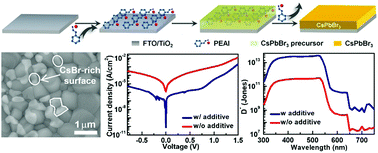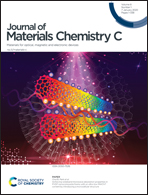Sacrificial additive-assisted film growth endows self-powered CsPbBr3 photodetectors with ultra-low dark current and high sensitivity†
Abstract
Inorganic halide perovskite CsPbBr3 is promising for stable, high-performance self-powered photodetectors (PDs). However, solution-processed polycrystalline CsPbBr3 films generally exhibit inferior photodetection performance in contrast to single-crystal and micro-/nano-structured counterparts, primarily because of their low carrier mobility and high defect density. We propose herein a sacrificial additive-assisted CsPbBr3 film growth strategy, in which a 2-phenylethanamine iodide (PEAI) additive was firstly introduced into a CsPbBr3 precursor film and then was extracted during CsPbBr3 film crystallization by high-temperature annealing. The as-obtained CsPbBr3 film exhibits multiple advantages of full coverage, pure phase, micro-sized grains, higher crystallinity, fewer defects, and particularly a CsBr-rich surface with less conductivity, compared with the control film prepared without PEAI sacrificial additive. The resulting self-powered PD with a simple configuration of FTO/TiO2/CsPbBr3/carbon yields an ultra-low dark current of 8.05 × 10−11 A cm−2, a high R of 0.35 A W−1, a superior D* of 3.83 × 1013 Jones, and a fast response time of 1.46 μs. These figures of merit are far beyond those of the one prepared with the control film and even most of self-powered CsPbBr3 PDs reported previously. Furthermore, the optimized PD exhibits excellent operational reliability and long-term stability in an ambient air atmosphere.



 Please wait while we load your content...
Please wait while we load your content...